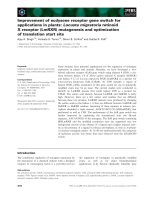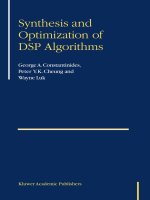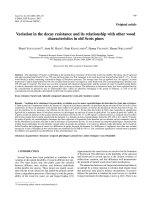Seasonal variation in leaf mineral nutrient and optimization of sampling dates for better indexing of pear leaf
Bạn đang xem bản rút gọn của tài liệu. Xem và tải ngay bản đầy đủ của tài liệu tại đây (301.19 KB, 6 trang )
Int.J.Curr.Microbiol.App.Sci (2019) 8(2): 1152-1157
International Journal of Current Microbiology and Applied Sciences
ISSN: 2319-7706 Volume 8 Number 02 (2019)
Journal homepage:
Original Research Article
/>
Seasonal Variation in Leaf Mineral Nutrient and Optimization of Sampling
Dates for Better Indexing of Pear Leaf
A. Raouf Malik1*, M. Feza Ahmad2, M. A. Ganie1, S.A. Bangroo 1, Nawsheen Nazir1,
Aroosa Khalil1 and R.H.S. Raja3
Sher-e-Kashmir University of Agricultural Sciences and Technology of Kashmir,
Shalimar, Srinagar, Jammu and Kashmir 191 121, India
2
Bihar Agricultural University Sobour Baghalpur 813210, India
3
Central Institute of Temperate Horticulture Srinagar J&K, India
*Corresponding author
ABSTRACT
Keywords
Pear, seasonal
variation, Leaf
index tissue,
Sampling Date,
Nutrient
Article Info
Accepted:
10 January 2019
Available Online:
10 February 2019
The present investigation aimed at evaluating the seasonality of macro-nutrients contents
of pear trees during the agriculture year 2007. Therefore, leaf samples were collected at
fortnightly intervals form 1st may to 1st October and evaluated for nutrients. In general
concentration of N, P,K decreased and those of Ca, Mg, Fe, and Mn content increased
from first to last sampling date while as no conspicuous trend was observed in Cu content
of leaves. The distinct period of stability for N, Mg, Mn and Zn contents occurred from
July 15- August 15. However, P content of leaves showed least variation from July 1 to
august 1. While stability period for leaf Ca was recorded from August 1 to September 1.
While Cu and B were found to be stable from June 1-July 15. It is as such suggested that
the leaves should be sampled form middle portion of current season growth from periphery
during most stable periods of a particular nutrient for its proper diagnosis. However in
general, July to August is the most representative period for diagnosis of leaf nutrient
content in the leaves.
Introduction
Pear (Pyrus communis L) is one of the most
important fruit crops of the world in India
pear is being mostly produced in J&K and
Himachal Pradesh , Foliar analysis has been
widely accepted as a valuable guide to
determine the fertility status in fruit plants.
Composition of nutrient in the leaf after six
months of planting indirectly reflects on the
growth, development and yield (Kumbargiri
et al., 2016).
Considerable work done on various fruit
crops suggest that best time for collecting leaf
samples is a relative stable period of a few
weeks or months when mineral shifts are at
minimum (Mason,1958). Several factors,
namely, leaf age, position, climate, cultivar
season etc, influenced nutrient concentration
in leaf (Robinson, 1981). Although, J & K is
one of the important pear producing states in
India, yet a standard sampling time has not
been developed for the leaf analysis. Thus
being a commercially important fruit crop of J
1152
Int.J.Curr.Microbiol.App.Sci (2019) 8(2): 1152-1157
& K, it was considered necessary to
standardize the optimum leaf sampling date
for pear which will provide correct
information about the nutritional status of
species growing in a particular locality and in
formulating fertilizer schedule.
Materials and Methods
The experiment was conducted at the
experimental orchard of the Division of
Pomology, SKUAST-K, Shalimar Srinagar
(J&K) during the year 2007-2008. Eight wellspaced healthy trees of pear cv. Bartlet and
cv. Chinese sandy pear of uniform age,
vigour and productivity were selected. Leaf
samples were collected from middle portion
of the current seasons growth from 1st May to
1st October at fortnightly intervals. The leaf
samples were thoroughly washed first with
tap water, then dipped in 0.1NHCl, distilled
water and finally in double distilled water.
After air drying, the samples were dried in
oven at 58oC till it attained constant weight.
The dried leaves were ground in steel willey
mill. Nitrogen was determined by micro
Kjeldhel method while phosphorus was
determined by Vanadomolybedo phosphoric
acid yellow colour method (Jackson, 1967).
Potassium and Calcium were estimated by
flame photometer. However, magnesium and
micronutrients were analyzed by atomic
absorption method using atomic absorption
spectrophotometer (ECIL 4141). However,
boron was analyzed through calorimeter.
Results and Discussion
The data presented in table 1 clearly indicate
that P, K, Ca and Mg contents were higher in
the leaves sampled from Chinese Sandy pear
while as leaf N content was found to be
higher in Bartlett leaves. The data related to
N, P and K content of pear leaves influenced
by sampling dates is presented in figure 4-6
respectively. Leaf N content decreased from
1.903 to 0.368 per cent from May 1 to
October (Fig. 4). While as P and K content
(Fig. 5 and 6) decreased from 0.350 per cent
to 0.136 per cent and 1.006 percent to 0.406
percent respectively from first sampling date
(May 1) to last sampling date (October 1).
The decreasing trend of N, P and K content of
pear leaves observed in present investigation
is associated with the growth dilution effect
(Smith, 1962). And also might be due to
utilization of these nutrients by various sinks
at different stages of development. The
decrease in N content during growing season
is in conformity to report of various workers
for both evergreen and deciduous fruit trees
(Koo and Young 1977 and Brown 1994). The
decrease in P and K content with the
advancement of growing season is also
confirmed by the findings of Kamboj et al.,
(1987), Chandel and Rana (2004) in Kiwi and
Ragini et al., (2015) in litchi. However the
stability period with respect to N, P and K
content of pear leaves was recorded from July
15, August 15, June 15 to July 15 and July 1
to August 1 respectively. Kamboj et al.,
(1987) reported distinct period of stability in
Patharnakh for N, P and K contents from July
to September. The variation in the stability
periods observed in the present findings might
be due to different agro-climatic conditions.
In contrast to primary nutrients, Ca and Mg
contents (Fig. 7 and 8) of leaves increased
with the advancement of leaf age. However a
decrease in leaf Mg content of pear was
recorded from September 15 onwards. The
increasing trend of Ca and Mg content of
leaves with age may be attributed to their
limited mobility in phloem (Smith, 1962).
While as the decrease in Mg content after
September 1 may be due to remobilization of
this element in the plant system. The lowest
Ca and Mg (Fig. 7 and 8) was recorded on
first date of sampling i.e. on May 1 (0.762%
Ca and 0.527% Mg). However, the maximum
level of Ca was recorded on October -1
(2.821%) while as that of Mg was observed
on September-1 (0.734%). The results of the
1153
Int.J.Curr.Microbiol.App.Sci (2019) 8(2): 1152-1157
present findings are in relation to the results
of Kamboj et al., (1987) and Rehalia and
Sandhu (2005) who also reported an increase
in Ca and Mg content with the advancement
of leaf age of pear leaves and in persimmon,
leaves respectively. In contrary Buwalda and
Meekings (1990) observed that the
concentration of Mg in spur leaves of pear
declined with the advancement of growing
season. The present investigation also
revealed that most nutrient stability period
(which is the most ideal leaf sampling date) in
pear leaves for Ca and Mg was July 1 August 15 and July 15 - August 15
respectively.
variation during July 15 to August 15 and
July 1 to August 1 respectively. The
increment in leaf nutrient content with leaf
age may be attributed to their fewer
requirements by the fruits as compared to
other elements (Raghupatri and Bhargava,
1996).
Copper content of pear leaves did not
followed a definite trend and a highest Cu
content was observed on first sampling date
i.e. on May 1 (21.79ppm) and after that
decreased gradually till June 15 (Fig. 8),
thereafter increased on July 1 and thereafter
again decreased towards the close of sampling
season. Copper content of leaves from June 1
to July 15 appeared to be stable. The trend
observed in the present investigation may be
due to relatively partial mobility of the
element in the plant system. Rossi (1970)
observed that in apple and pear leaf copper
content increased up to May and then
decreased with advancement of sampling
period till September.
As far as micronutrients are concerned, Mn,
Zn and B were recorded higher in Chinese
sandy pear than that of Bartlet leaves (Table
1). While as Cu was found to be higher in cv.
Bartlet, however, a non significant difference
was recorded in Fe content of two cultivars.
The studies on periodical variation of Mn and
Fe (Fig. 6 and 7) exhibited an increasing trend
as the season advanced, till September 1,
thereafter, a decreasing trend was recorded till
last date of sampling. The maximum content
of Mn and Fe was recorded on September 1
(84.59 ppm and 177.36 ppm, respectively)
(Fig. 6 and 7). While as minimum leaf Mn
and Fe was recorded on May 1 (42.94 ppm
and 117.34 ppm, respectively). Further Mn
and Fe content of Pear leaf attained least
The leaf Zn content (Fig. 9) of leaves
increased from the first date of sampling i.e.
May 1 to June 1. Then decreased afterwards
to reach its minimum on October 1. While as
boron concentration (Fig. 10) of leaves
showed a general decrease throughout the
season.
Table.1 Varietal effect of pear on leaf macro and micro-nutrient content
Varieties
Chinese
Sandy Pear
Bartlett
CD
(P<0.05)
Primary Nutrient
Secondary
Nutrient
Micro-nutrient
Nitrogen
(%)
Phosphorus
(%)
Potassium
(%)
Calcium
(%)
Magnesium
(%)
Manganese
(ppm)
Iron
(ppm)
1.202
0.183
0.751
2.167
0.680
70.61
1.580
0.040
0.168
0.006
0.441
0.046
1.703
0.029
0.663
NS
57.89
3.33
1154
Copper
(ppm)
Zinc
(ppm)
Boron
(ppm)
158.40 16.02
31.00
41.36
155.51 21.50
NS
1.21
24090 36.8
0.92
1.24
Int.J.Curr.Microbiol.App.Sci (2019) 8(2): 1152-1157
1155
Int.J.Curr.Microbiol.App.Sci (2019) 8(2): 1152-1157
The maximum B was recorded on May 1
(48.15 ppm) and minimum on October 1
(25.90 ppm). However, least variation in Zn
and B content of pear leaves was recorded
during July 15 to August 15 and June 15 to
July 15 respectively. The maximum level of
Zn content on earlier sampling dates may be
due to the fact that period of greater
accumulation of Zn occurs between leaf
emergence and fruit set (Smith et al., 1987)
while as the depletion in leaf B around
anthesis may be linked to B mobilization from
the leaves to supply B requirement of flowers
and fruits (Delgado et al., 1994).
The periodical variation on leaf nutrient
concentration in pear indicate that in general
nitrogen , phosphorus, potassium, zinc and
boron decreased with the advancement of leaf
sampling period while as calcium,
magnesium, manganese, and iron increased
with the leaf age. However, copper content of
the leaves from pear did not show any regular
trend. Further, it is often difficult to select a
sampling date which is suitable for all
nutrients because of difference in their
seasonal trends (Cresswell and Wickson,
1986). One compromise is to choose a
sampling date when the concentration of most
nutrients is more stable. From Figure 1-10 it
can be seen that most of the nutrients show
least variation from July to August. Thus July
to August can be regarded as the optimal
sampling date for diagnosis of nutrient status
of pear tree. It is as such suggested that the
pear leaves should be sampled from middle
portion of current seasons growth from
periphery during July to August for
simultaneous analysis of nutrients. However
for a particular nutrient diagnosis, the leaves
should be sampled from the current season
growth during the stability period for that
particular nutrient.
References
Brown P H. 1994. Seasonal variation in fig
(Gicus carica L.) leaf nutrient
concentrations. Horticultural Sciences
29(8): 871-873.
Buwalda J G and Meekings J S. 1990.
Seasonal accumulation of mineral
nutrient in leaves and fruit of Japanese
pear (Prunus serotina Rehd.). Scientia
Horticulture 41: 209-222.
Chandel, J.S. and Rana, R. K.(2004).
Standardization of leaf sampling
techniques for kiwi fruit in mid hill
conditions of Himachal Pradesh.
Haryana J Hortl Sci., 33 (1&2):30-33.
Cresswell G C and Wickson R J. 1986.
Seasonal variation in the nutrient
composition of the foliage of pecan.
Aust. J. Exp. Agri. 26: 393-397.
Delgado A, Benlloch M and Fernandez E R.
1994. Mobilization of boron in olive
trees during flowering and fruit
development. Hort. Sci. 29: 616-618.
1156
Int.J.Curr.Microbiol.App.Sci (2019) 8(2): 1152-1157
Jackson M L. 1967. Soil chemical analysis,
Asia Publishing House, Bombay.
Kamboj J S, Datt A S and Rehalia A S. 1987.
Standardization of leaf sampling
technique in subtropical pear. Punjab
Hor. J. 27 (3-4): 121-132.
Koo R C J and Young T W. 1977. Effects of
age, position and fruiting status on
mineral composition of ‘Tonnage’
avocado leaves. J. Amer. Soc. Hort. Sci.
102: 311-313.
Kumbargire, G. A. Swamy, G. S. K. and
Kalatippi, A. S. 2016. Influence of
diatomaceous earth as source of silicon
on leaf nutrient status and yield
attributing characters of banana cv.
Grand Naine. The Bioscan 11(1): 435438,
Mason A C. 1958. The concentration of
certain nutrient elements in apple leaves
taken from different positions on shoot
and at different dates throughout the
growing season. J. of Hort. Sci. 33: 128138.
Raghupathi H B and Bhargava B S. 1998.
Leaf and soil nutrient diagnosis norms
for pomegranate (Punica granatum L.).
J. of the Indian Soci. of Soil Scien. 46
(3): 412-416.
Ragini, K. Prabhakar, M. Kumari, N. Rajeev,
K. and Rajendra P. S. 2015. Temporal
and axial variation for primary nutrient
concentration in leaves of litchi. The
Bioscan. 10(3): 1145-1148.
Rehalia, A.S.and Sandhu, R.D. 2005.
Standardization of foliar sampling
technique
for
micronutrients
in
persimmon (Diospyrous Kaki L.). Acta
Hortic., 696:265-268
Robinson A D. 1981. Principles and
approaches used in plant analysis.
Proceedings of National Workshop
Plant Analysis Report, 34-37.
Rossi N. 1970. The macro and micro nutrient
contents of the leaves some of apple and
pear in orchard in Emila, Cent. Edafol.
Bio. Aplic. Curato. Sevilea, Spain 607615.
Smith G S, Clark C J and Henderson H V.
1987. Seasonal accumulation of mineral
nutrients by kiwifruit. New Phytol 106
(1): 81-100.
Smith P F. 1962. Mineral analysis of plant
tissues. Ann. Rev. of Plant Physiol. 13:
81-108.
How to cite this article:
Raouf Malik, A., M. Feza Ahmad, M.A. Ganie, S.A. Bangroo, Nawsheen Nazir, Aroosa Khalil
and Raja, R.H.S. 2019. Seasonal Variation in Leaf Mineral Nutrient and Optimization of
Sampling Dates for Better Indexing of Pear Leaf. Int.J.Curr.Microbiol.App.Sci. 8(02): 11521157. doi: />
1157









